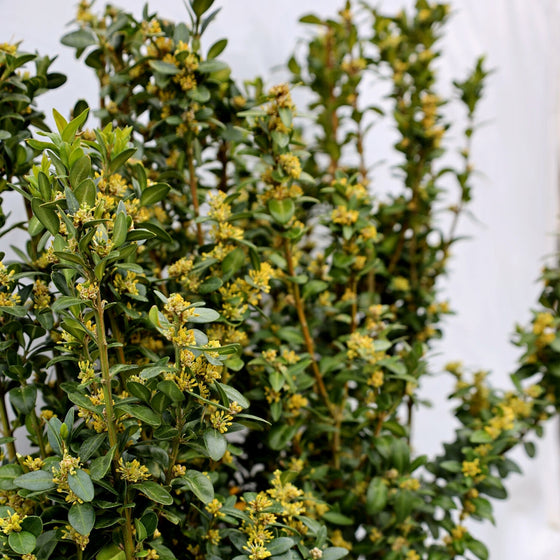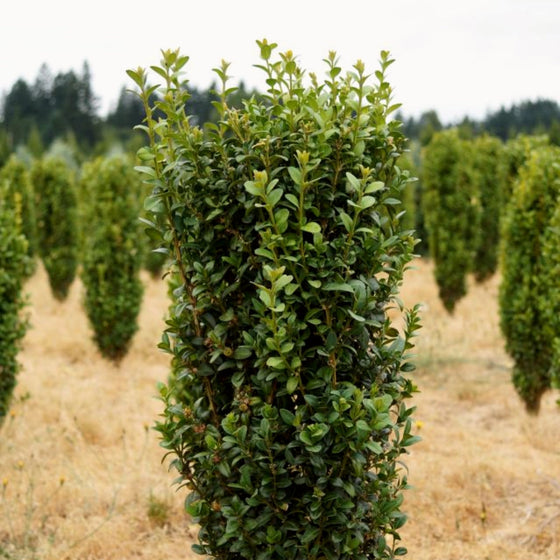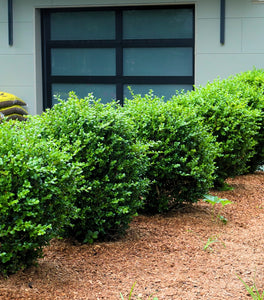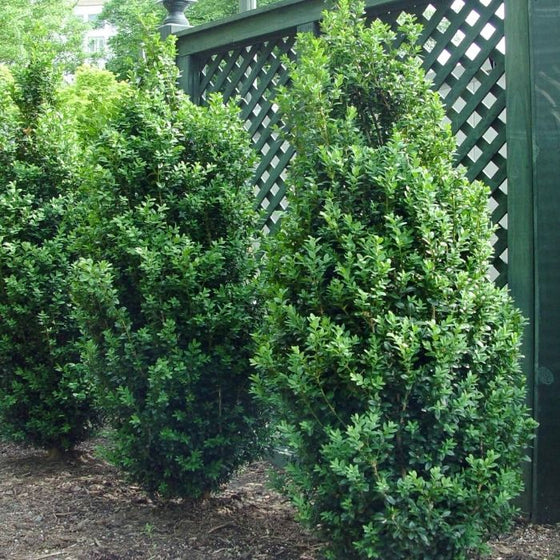
Images Depict Mature Plants
Dee Runk Boxwood – Upright Columnar Evergreen Shrub for Hedges and Entryways
A narrow boxwood with bold vertical presence.
The Dee Runk Boxwood (Buxus sempervirens ‘Dee Runk’) is a standout evergreen shrub prized for its slim, columnar growth habit. Unlike rounded boxwoods, Dee Runk grows tall and narrow, reaching 8–10 feet in height but only 2–3 feet in width, making it the perfect solution for tight spaces, narrow borders, and vertical accents in formal or modern landscapes.
Perfect for hedges, entryways, and walkways.
Dee Runk Boxwood’s naturally upright form makes it a favorite for use as a privacy hedge, in foundation plantings, and as a framing element for entryways. Its dense, dark green foliage remains lush throughout the year, offering reliable evergreen coverage in every season. Whether you’re creating a formal garden or accenting a walkway, Dee Runk provides height and elegance without overwhelming smaller spaces.
Low-maintenance and adaptable.
This upright boxwood is as tough as it is beautiful. Hardy in USDA Zones 5–8, Dee Runk tolerates both heat and cold and adapts well to a variety of soils as long as drainage is good. Once established, it requires little more than occasional pruning to maintain shape, making it an excellent low-maintenance evergreen for homeowners who want structure without constant upkeep.
A timeless evergreen with year-round beauty.
Dee Runk Boxwood is ideal for gardeners who adore the classic look of boxwoods but crave a distinctive twist. Its narrow form and rich evergreen color make it one of the most versatile boxwoods for small-space landscapes, urban gardens, and formal designs. If you’re looking for a shrub that combines strength, beauty, and elegance, Dee Runk Boxwood is one of the best choices available.
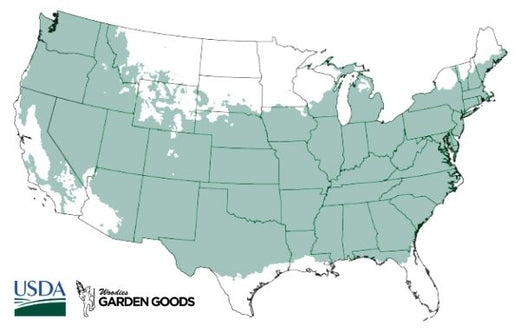
| Hardiness Zone: | 5-8 |
|---|---|
| Mature Height: | 8 to 10 Feet |
| Mature Width: | 2 to 3 Feet |
| Classification: | Evergreen shrub |
| Sunlight: | Full sun to partial shade |
| Habit: | Upright |
| Foliage: | Green |
| Soil Condition: | Any well-drained soil |
| Water Requirements: | Water well until established |
How to Care for Dee Runk Boxwood
Be sure to read our Dee Runk Boxwood planting and care guide.
How do I plant Dee Runk Boxwood shrubs?
Choose a site with full sun to partial shade and well-draining soil. Dig a hole twice as wide as the root ball and just as deep. Place the shrub upright, backfill halfway, water thoroughly, then finish filling and water again. For hedges, space Dee Runk Boxwoods 2–3 feet apart to form a dense evergreen wall. Apply a 2–3 inch mulch layer around the base to help conserve moisture and suppress weeds, keeping mulch a few inches away from the trunk to prevent rot.
How often should I water Dee Runk Boxwood?
Water deeply 1–2 times per week during the first year to establish a strong root system. Adjust based on rainfall and soil type, ensuring the soil stays evenly moist but never soggy. Once established, Dee Runk Boxwood is drought-tolerant and only needs supplemental watering during prolonged dry periods. Consistent watering early on will ensure quicker establishment and denser growth.
When and how should I fertilize Dee Runk Boxwood?
Fertilize in early spring with a balanced, slow-release fertilizer for evergreen shrubs. Apply evenly around the root zone and water well to activate nutrients. A second light application in midsummer may benefit younger plants, while mature shrubs typically thrive with just one spring feeding per year.
-v1646343254325.png?89x89)
Does Dee Runk Boxwood need pruning?
Thanks to its naturally upright growth habit, Dee Runk Boxwood requires minimal pruning. A light trim in late spring or early summer will help maintain its narrow form and encourage denser foliage. For formal hedges, prune annually to achieve crisp lines. Avoid heavy pruning into old wood, as boxwoods do not recover well from severe cuts.

